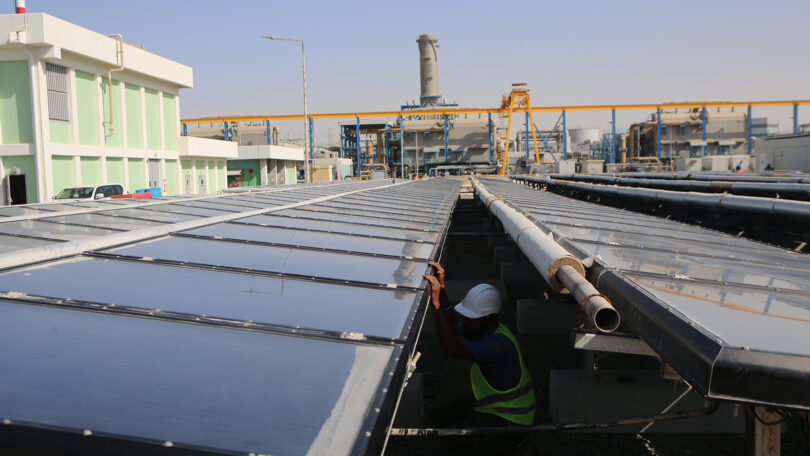We caught up with Louise Bleach, vice president of business development at Desolenator, to find out more about their unique approach to solar desalination.
When astronauts first went to space they looked back and marvelled at the mighty blue planet we call home.
Over 70% of the Earth’s surface is covered in water. But crucially, only 0.5% of that water is fresh and available for use.
This freshwater – found in our lakes, rivers and underground – is essential for our survival. But as populations grow and climate change accelerates, water scarcity worsens. Even today, 1 in 3 people do not have access to safe drinking water.
Ensuring the availability and sustainable management of water and sanitation for all, as outlined in UN SDG 6, is one of greatest challenges of our time and requires significant investment, and immediate action.
The first port of call is to conserve and restore the quality of the 0.5% of freshwater we have available and make it equitably accessible. But what about those parts of the world where freshwater simply isn’t available?
According to UNICEF, over two billion people live in countries where water supply is inadequate, and half of the world’s population could be living in areas facing water scarcity by as early as 2025.
In some situations, the best option is to turn to the remaining 97% – the oceans.
Desalination of saltwater for drinking isn’t knew. In its simplest form it has been practiced for centuries, but was formalised more recently in the 50s and 60s.
The most popular methods are thermal desalination and reverse osmosis. Thermal desalination uses heat to vaporise fresh water from seawater or brackish water.
Reverse osmosis separates fresh water by forcing seawater or brackish water through a membrane at high pressure.
Globally, more than 300 million people depend on desalination, with several countries, such as the Bahamas, Maldives and Malta, relying on the technology for all their water needs.
The Middle East accounts for just under half of total capacity, while Asia, China, the United States, and South America are scaling up their desalination capacity fast.
Today, there are more than 17,000 desalination plants globally, producing 107 million cubic meters of desalinated water every day.
So what’s the catch?
“The current approach to desalination is simply unsustainable,” says Louise Bleach, vice president of business development at Desolenator. “It is highly energy and carbon intensive, costly, and produces a toxic brine that is often discharged into the marine environment.”
According to one report published in Nature, Each 1000 cubic meters of seawater processed releases as much as 6.7 tons of CO2. And with new desalination plants popping up across the world each year – that’s a whole lot of emissions.
Furthermore, in most desalination processes, for every litre of potable water produced, about 1.5 litres of toxic brine – a combination of salty water and chemicals – is created.
These two factors hinder the viability of the desalination industry and threaten the health of the planet.
Thankfully, in recent years there has been a surge of innovations and new ideas looking to drive a step-change in the way we extract freshwater from the sea.
One of these innovators is Desolenator, a London-based startup founded in 2014, that says it has developed the world’s first solar thermal desalination technology which delivers net-zero water.
The company aims to provide water to communities in dry and often remote regions, but with minimal environment impacts. It does this by tackling desalination’s current pitfalls head on.
Desolentor uses solar panels to power the entire system. More specifically, a ‘hybrid’ type of solar panel which is a combination of regular PV and solar thermal technology – known as Photovoltaic Thermal (PVT).
“Harnessing both the electrical and thermal properties of the sun makes it up to four times more efficient than regular solar panels,” says Louise.
The electrical energy is used to power the control systems, auxillary systems and pumps, while the thermal energy powers the Multi Effect Desalination
(MED) unit. An MED evaporates sea water at low temperatures in order to produce clean distillate water.
While most MEDs are the size of a house, Desolenator has reduced there’s to about the size of a car – making it modular and easier to setup in remote areas.
By using this method, the company avoids using membranes or harmful chemicals which in turn avoids the production of a toxic brine.
The company is currently looking to certify their brine as ‘ocean safe’. In fact, Desolenator is one of the only desalination companies to be funded by an ocean impact fund – a testament to their proactiveness on the problem.
After years of R&D and pilot projects, Desolenator launched their first fully operational solar thermal desalination plant in Dubai in March. The pilot plant has a capacity of 20,000 litres per day and was launched in collaboration with the Dubai Electricity and Water Authority (DEWA).
The success of the pilot plant would technically validate Desolenator’s technology, which would have significant implications for the region and beyond, the company said.
After the successful completion of this project, Desolenator and DEWA intend to establish a joint venture company with the aim of commercialising this technology.
“The partnership between DEWA and Desolenator embodies the importance of fruitful cooperation between the public and private sectors to develop new solutions based on the latest technologies to meet the various challenges,” said Khalfan Belhoul, Chief Executive Officer of Dubai Future Foundation.
The pilot plant was installed at DEWA’s Jebel Ali Power Plant and Desalination Complex. This gas- and -oil powered facility is the largest seawater desalination plant in the world – producing a whopping 2 billion litres of freshwater per day.
The two plants now stand side by side – the old and the new.
Countries like Dubai rely on desalination for their livelihoods but up till now this process has been completely reliant on fossil fuels. As solar power becomes increasingly price-competitive and the climate emergency ever more urgent, solar desalination increasingly becomes the only viable option.
“To address the global water and climate crisis, we need new forms of collaboration between innovators and organisations and DEWA have shown a vision and support that stands as a great example for the world,” concludes William Janssen, CEO of Desolenator.







